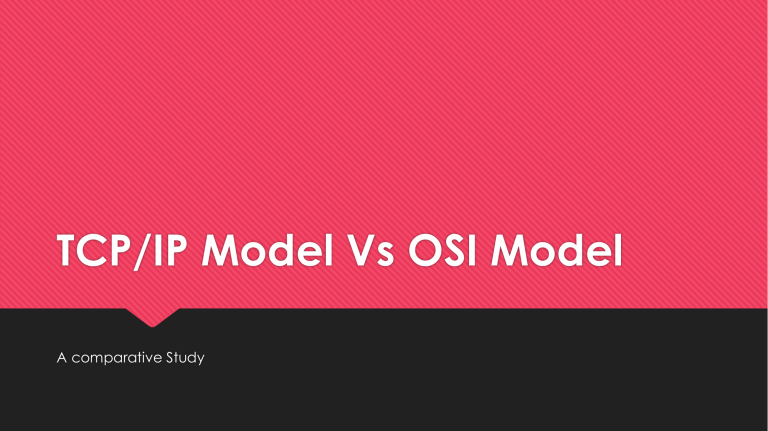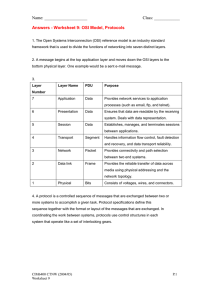
TCP/IP Model Vs OSI Model A comparative Study Application Layer OSI Model Presentation Layer Software Layers Session Layer OSI stands for Open Systems Interconnection. It has been developed by ISO – ‘International Organization of Standardization‘, in the year 1984. It is a 7 layer architecture with each layer having specific functionality to perform. All these 7 layers work collaboratively to transmit the data from one person to another across the globe. Transport Layer Heart Of OSI Network Layer Data Link Layer Physical Layer Hardware Layers 1. Physical Layer (Layer 1) : The lowest layer of the OSI reference model is the physical layer. It is responsible for the actual physical connection between the devices. The physical layer contains information in the form of bits. 7. Application Layer (Layer 7) : At the very top of the OSI Reference Model stack of layers, we find Application layer which is implemented by the network applications. These applications produce the data, which has to be transferred over the network. This layer also serves as a window for the application services to access the network and for displaying the received information to the user. 2. Data Link Layer (DLL) (Layer 2) : The data link layer is responsible for the node to node delivery of the message. The main function of this layer is to make sure data transfer is error-free from one node to another, over the physical layer Layers of OSI Model 3. Network Layer (Layer 3) : Network layer works for the transmission of data from one host to the other located in different networks. 4. Transport Layer (Layer 4) : Transport layer provides services to application layer and takes services from network layer. The data in the transport layer is referred to as Segments. 5. Session Layer (Layer 5) : 6. Presentation Layer (Layer 6) : Presentation layer is also called the Translation layer.The data from the application layer is extracted here and manipulated as per the required format to transmit over the network. This layer is responsible for establishment of connection, maintenance of sessions, authentication and also ensures security. TCP/IP Model TCP/IP model, it was designed and developed by Department of Defense (DoD) in 1960s and is based on standard protocols. It stands for Transmission Control Protocol/Internet Protocol. The TCP/IP model is a concise version of the OSI model. It contains four layers, unlike seven layers in the OSI model. The layers are: 1. Process/Application Layer 2. Host-to-Host/Transport Layer 3. Internet Layer 4. Network Access/Link Layer 1. Network Access Layer – This layer corresponds to the combination of Data Link Layer and Physical Layer of the OSI model. It looks out for hardware addressing and the protocols present in this layer allows for the physical transmission of data. We just talked about ARP being a protocol of Internet layer, but there is a conflict about declaring it as a protocol of Internet Layer or Network access layer. It is described as residing in layer 3, being encapsulated by layer 2 protocols. 2. Internet Layer – This layer parallels the functions of OSI’s Network layer. It defines the protocols which are responsible for logical transmission of data over the entire network. The main protocols residing at this layer are : IP, ICMP and ARP Layers Of TCP/IP Model 3. Host-to-Host Layer – 4. Application Layer – This layer is analogous to the transport layer of the OSI model. It is responsible for end-to-end communication and error-free delivery of data. It shields the upper-layer applications from the complexities of data. The two main protocols present in this layer are : This layer performs the functions of top three layers of the OSI model: Application, Presentation and Session Layer. It is responsible for node-to-node communication and controls user-interface specifications. Some of the protocols present in this layer are: HTTP, HTTPS, FTP, TFTP, Telnet, SSH, SMTP, SNMP, NTP, DNS, DHCP, NFS, X Window, LPD. TCP and UDP Differences o OSI model is a generic model that is based upon functionalities of each layer. TCP/IP model is a protocol-oriented standard. o OSI model distinguishes the three concepts, namely, services, interfaces, and protocols. TCP/IP does not have a clear distinction between these three. o OSI model gives guidelines on how communication needs to be done, while TCP/IP protocols layout standards on which the Internet was developed. So, TCP/IP is a more practical model. o In OSI, the model was developed first and then the protocols in each layer were developed. In the TCP/IP suite, the protocols were developed first and then the model was developed. o The OSI has seven layers while the TCP/IP has four layers. Similarities o Both the reference models are based upon layered architecture. o The layers in the models are compared with each other. The physical layer and the data link layer of the OSI model correspond to the link layer of the TCP/IP model. The network layers and the transport layers are the same in both the models. The session layer, the presentation layer and the application layer of the OSI model together form the application layer of the TCP/IP model. o In both the models, protocols are defined in a layer-wise manner. o In both models, data is divided into packets and each packet may take the individual route from the source to the destination. Application Presentation Application Session Transport Transport Network Network Data Link Network Interface Physical A presentation prepared by: Raghav Pasrija 02711504920 EEE-1st Year Thank You!





